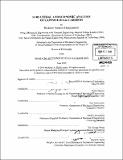| dc.contributor.advisor | Henry Marcus. | en_US |
| dc.contributor.author | Hadjiyiannis, Nicholas | en_US |
| dc.contributor.other | Massachusetts Institute of Technology. Dept. of Mechanical Engineering. | en_US |
| dc.date.accessioned | 2011-03-07T15:22:23Z | |
| dc.date.available | 2011-03-07T15:22:23Z | |
| dc.date.copyright | 2010 | en_US |
| dc.date.issued | 2010 | en_US |
| dc.identifier.uri | http://hdl.handle.net/1721.1/61605 | |
| dc.description | Thesis (Ph. D.)--Massachusetts Institute of Technology, Dept. of Mechanical Engineering, 2010. | en_US |
| dc.description | Cataloged from PDF version of thesis. | en_US |
| dc.description | Includes bibliographical references (p. 935-1001). | en_US |
| dc.description.abstract | Structural failures of bulk carriers continue to account for the loss of many lives every year. Capes are particularly vulnerable to cracking because of their large length, their trade in high density cargos, and the high rates of cargo operations. Rapid loss often occurs allowing little reaction time which has alarmed the industry. The Cape market is extremely volatile with ship values appreciating in some cases by over 500% and then returning to original levels, all within a few years. Recent market changes have rendered conventional pricing methods inaccurate and often inapplicable, resulting in a pressing need for alternate valuation models. Very little research combines the closely interlinked technical and financial elements which are crucial for valuation and decision making by various parties in the shipping industry. The present research involves the collection and analysis of one of the largest ship cracking surveys. It is focused specifically on capes which lie at the core of the problem and is based on the records of ship owners, classification societies and shipyards. A location coding system was specifically designed to analyze the data and present the frequency, size and estimated crack growth rates with respect to location and ship age. The results were compared with existing knowledge based on surveys conducted over the past 50 years, the stress distribution based on an investigation of loading patterns, and theoretical fracture mechanics predictions. They were then combined with the frequency of crack failures, derived from an investigation of an extensive fleet sample, to develop a reliability model which yields the hazard function throughout the ship's life. Repair procedures and design modifications were also examined and a model was designed to assess their cost effectiveness based on the present value of projected crack costs. The crack repair costs were calculated as a function of ship age to be used in conjunction with the safety assessment for decision making by ship owners, insurance companies, classification societies and others. A new state of the art valuation model was developed combining both technical and financial aspects in a fundamental valuation based on risk-adjusted discounting of expected cash flows. A forward view of the main parameters was obtained from derivatives and financial securities that include shipping futures, FFAs, options, interest rate swaps and inflation protected bonds. The inherent risk of cracks is treated as a fictitious credit risk, derived from the reliability model, and is incorporated into the discount rate along with other risk premiums. Other inputs include repair costs and off-hire time, which were calculated with respect to ship age using a database of repairs, while the records of public and private companies were used along with surveys to estimate operating expenses. The resulting valuations were found to be in very close alignment with recent transaction prices across all ship ages. The model also estimates the volatility of the ship value and uses it to price optionalities that are often included in ship transactions. The combination of technical and financial analysis of this thesis is valuable to many involved in the shipping industry including brokers, accountants, analysts, shipping banks and investors interested in valuation; ship owners when making managerial or investment decisions; shipyards when designing ships, setting prices and deciding payment structures and options; insurance companies when covering total loss or emergency repairs; the IMO when setting regulations; and classification societies when scheduling inspections and deciding which areas to focus on. | en_US |
| dc.description.statementofresponsibility | by Nicholas Andrew Hadjiyiannis. | en_US |
| dc.format.extent | 1001 p. | en_US |
| dc.language.iso | eng | en_US |
| dc.publisher | Massachusetts Institute of Technology | en_US |
| dc.rights | M.I.T. theses are protected by
copyright. They may be viewed from this source for any purpose, but
reproduction or distribution in any format is prohibited without written
permission. See provided URL for inquiries about permission. | en_US |
| dc.rights.uri | http://dspace.mit.edu/handle/1721.1/7582 | en_US |
| dc.subject | Mechanical Engineering. | en_US |
| dc.title | Structural and economic analysis of capesize bulk carriers | en_US |
| dc.type | Thesis | en_US |
| dc.description.degree | Ph.D. | en_US |
| dc.contributor.department | Massachusetts Institute of Technology. Department of Mechanical Engineering | |
| dc.identifier.oclc | 704563968 | en_US |

